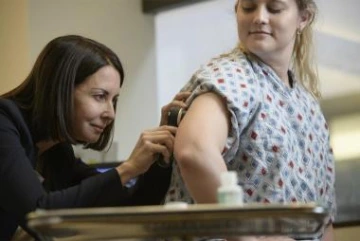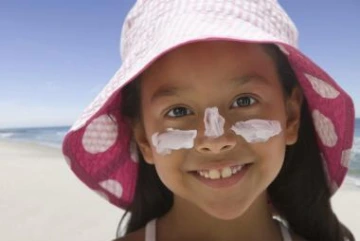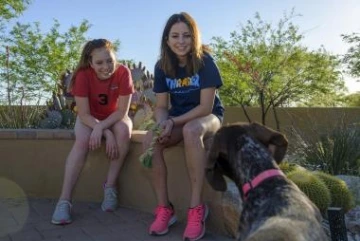Tips for Staying Sun-Safe Year Round
Health Sciences educator Lisa Quale of the Skin Cancer Institute says the wintertime is no time to ease up on protection from the sun.

Arizona is famous for its ample sunshine – a blessing and a curse. Warm and bright surroundings are ideal for enjoying outdoor activities, but too much sun can harm the skin. Even in the wintertime, the sun’s ultraviolet (UV) rays can knock the letters of your DNA out of place, causing genetic “typos” that lead to skin cancers, such as melanoma, a common type of cancer in the United States.
lisa_quale-inline.jpg

Lisa Quale
Lisa Quale, health educator at the University of Arizona Skin Cancer Institute, began her career with the UArizona Cancer Center in 2002, and has been with the Skin Cancer Institute since it was established in 2006. Since then, she has educated patients, overseen all educational materials, and aided in developing brochures, videos, and website information on skin cancer prevention and detection.
She shares why sun safety is important all year round.
Why do people need to be mindful about sun safety, even in the winter?
The sun is always out there, emitting damaging rays. UVA rays are the same intensity all year round. UVB rays, the burning rays, aren’t as prevalent in the wintertime, but it’s still possible to get a sunburn, especially if you’re overexposing yourself to the sun and not wearing sunscreen. When I was a kid, I had some of the worst burns of my life in the winter!
In the summertime, warmth on the skin is a constant reminder to people that their skin is being bombarded by the sun, so people are really good about wearing sunscreen or finding shade. In the wintertime, sun damage isn’t at the forefront of their mind, and they’re not doing things to protect themselves from the sun. You’ve still got to be safe in the wintertime, even though it doesn’t feel like you have to be.
201706946-curiel_skin_0658-inline.jpg

A dermatologist needs to exam your skin up close to make a proper diagnosis. Pictured here: Clara Curiel, MD, co-director of the Skin Cancer Institute.
Since people generally cover up more in the winter, more than anything, I tell them to wear their sunscreen. You always need it anywhere your skin is exposed to the sun, like your face. Never forget the hat or the sunglasses, those are good all year round. Be mindful of how much sun you’re getting. Even though it doesn’t feel like you’re getting as much sun exposure, you are. Wear sunscreen, cover up, do everything you do in the summertime.
Is it a good idea to delay or avoid routine exams, like dermatological exams, to reduce COVID-19 risk during a pandemic?
No, you shouldn’t delay routine exams — of any kind, not just dermatology. People should stay on their schedules — and certainly, if you see a spot, if you notice something new or unusual on your skin, have it checked as soon as possible, regardless of the pandemic.
beach_kid_sunscreen-sb10068682p-001-inline.jpg
Anyone with skin is at risk for skin cancer. Tools like sunscreen and hats go a long way to protect the skin.

Anyone with skin is at risk for skin cancer. Tools like sunscreen and hats go a long way to protect the skin.
Medical facilities in general are doing everything they can to keep things safe during this time. They are being especially careful about having too many people in the waiting room. They try to get people roomed as quickly as they can. Everybody is screened for COVID-19 symptoms. Everybody’s wearing face masks.
A lot of people are opting for telemedicine meetings with their health care providers during the pandemic. Dermatology is a tough one to do over telemedicine. They may be able to diagnose and treat some skin issues this way, but skin cancer is not one of them. If you want to be screened for skin cancer, or have a definitive answer on whether a spot is a potential skin cancer, you have to go in. Dermatologists have special tools, whether they need to use their dermatoscope to see a spot more deeply or take a biopsy to decide whether it’s skin cancer. Plus, they need to be able to see your skin and do a full-body exam to screen for skin cancer.
Can I track my dermatological health at home?
Absolutely. Anybody who has skin can get skin cancer. You can take your health into your own hands at home by doing a monthly skin exam. You start at the top, you work your way down, check it all. Anywhere you have skin, you want to check.
sooter_teens_klh6606-inline.jpg
Even in the wintertime, avoid the sun by seeking shade and applying sunscreen to exposed skin.

Even in the wintertime, avoid the sun by seeking shade and applying sunscreen to exposed skin.
There are smartphone apps that have reminders to do your skin exam, and they can save pictures you take of spots you’re worried about and track the changes too. The apps help promote skin health and give people a little bit of education about what to look for, but I worry that people are going to start using these apps as an excuse not to see the dermatologist regularly. These apps are not designed to replace doctors.
The FDA is reviewing its guidelines on which sunscreen ingredients are safe and effective. Does that mean the sunscreen on the market now isn’t safe or effective?
About a year ago, the FDA proposed a new regulation to clarify the safety and effectiveness of sunscreen ingredients. Under the rule, makers of sunscreen would have to provide the FDA with safety data if their products had any active ingredients other than zinc oxide or titanium dioxide, the two that they already consider “GRASE” (Generally Recognized As Safe and Effective).
The FDA’s proposed rule is basically saying that most of the other sunscreen ingredients need more research to be able to say, yes, they’re effective, and yes, they’re safe. It’s not that they aren’t, it’s just that they want to see more research that can back that up. I don’t know how long it could take to get sufficient research on those ingredients, but I’m glad the FDA is thinking about it.
There are two ingredients the FDA sees as not GRASE: PABA and trolamine salicylate. People don’t have to check ingredients for either of those — sunscreen manufacturers stopped using them years ago.
You’ve been at the Skin Cancer Institute for 15 years. What’s changed in that time?
I’ve been able to see the progress that places like the Skin Cancer Institute have made over the last decade-plus, and that’s great. I’ve seen people go from, “Skin cancer, that’s not a big deal, I would never die from that,” to understanding that melanoma can kill you, and understanding that if you stay out of the sun, you can reduce your odds of getting skin cancer.
A lot of little things have changed over the years, thanks to different places that have started educating the community and reaching out to different populations. As a child in grade school, we could not bring sunscreen to school because it was considered an over-the-counter drug. Now in Arizona it is completely fine — you can bring your sunscreen, you can have a teacher’s aide help you put it on, you can keep it in your backpack. More schools allow you to wear hats when you go outside for recess now, too. It’s been a really nice progression to watch people become more sun safe than they used to be. It’s why I’m in this business.
This article originally appeared in Health Sciences Connect.



